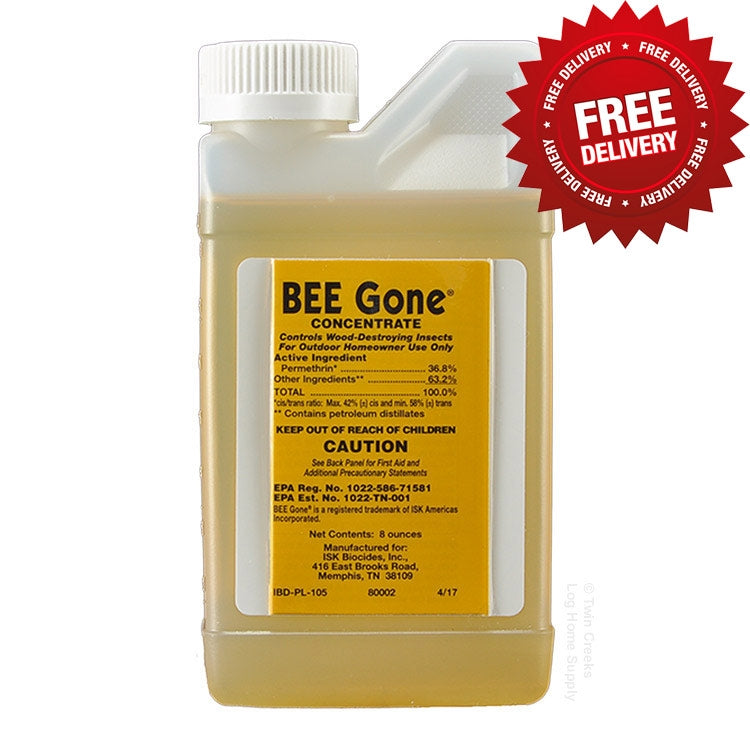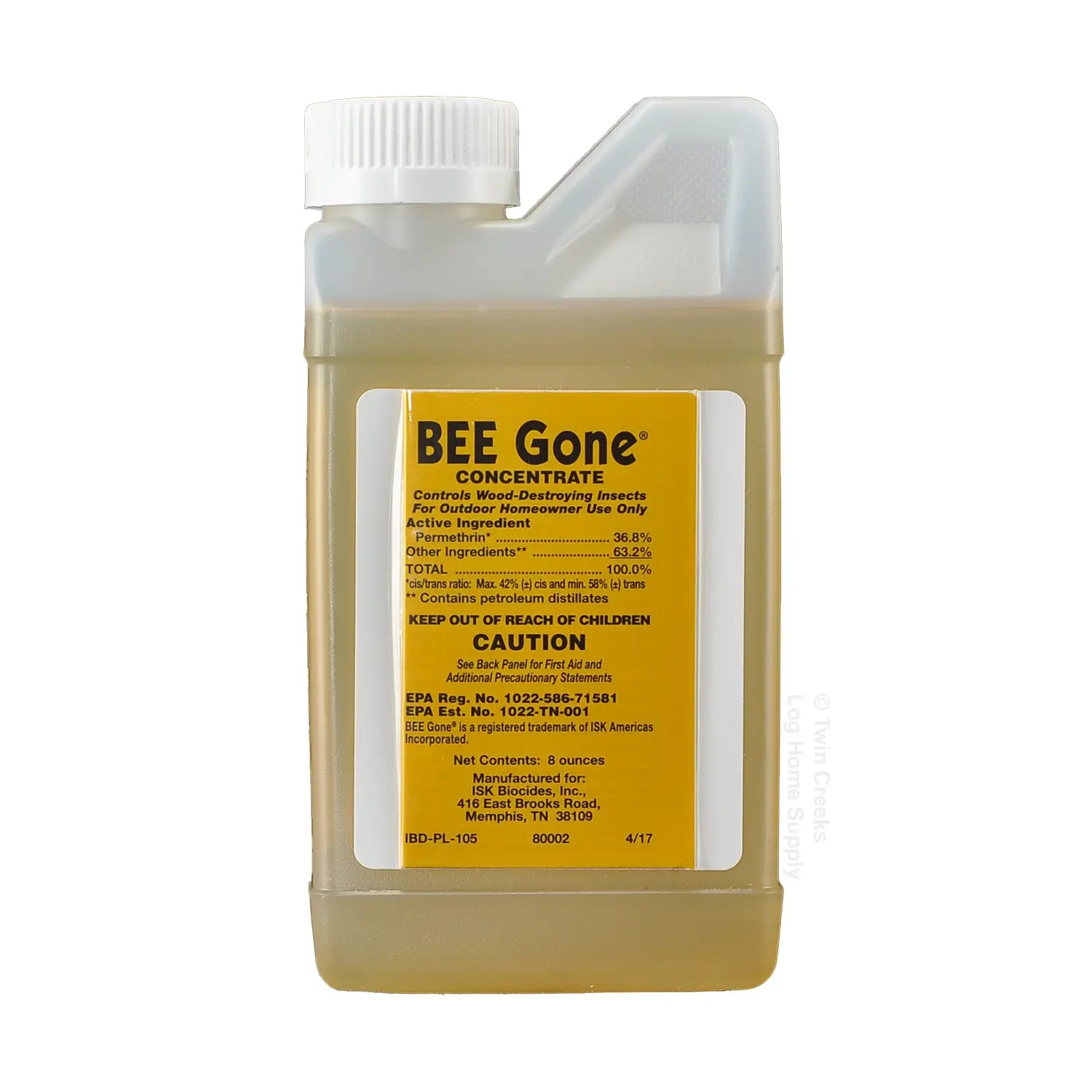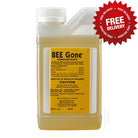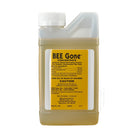Bee Gone Insecticide Concentrate - 8 Oz. Bottle
Details
Free Shipping
We are offering free shipping for this product when shipping to the Lower 48 United States. Offer does not apply to Alaska, Hawaii, and the US Territories. Free Shipping applies to this item only and not the entire order.
Bee Gone Insecticide Concentrate is an EPA registered Pyrethroid insecticide which can be applied in Wood Guard exterior stain or water to wooden structural surfaces on residential buildings. Bee Gone controls a wide range of insects, including beetles, spiders and all forms of bees. Bee Gone may also be used to control home-invading insects as a residual spray on outside surfaces, such as walks, garbage areas, window frames, doorways, porches, and patios. Bee Gone should not be used on plants being grown for commercial sale, or plants grown for seed production or sod farms and golf course turf, or in greenhouses or nurseries.
Bee Gone Insecticide Concentrate Features and Benefits
• EPA Registered Insecticide.
• Effective against Carpenter Bees, Ants, Spiders, Beetles, Box Elder Bugs, Centipedes, Scorpions, Ticks, and Wasps.
• Non-staining to most home sidings.
• Easy clean up with water.
• No harsh odors or solvents.
Bee Gone Insecticide Concentrate Mixing Instructions
• Mixing Instructions: Mix 1.6 fluid oz. (3 1/4 Tablespoons) of Bee Gone Concentrate per 1 gallon of spray solution to make a 0.5% spray emulsion [1 fluid oz. = 2 Tablespoons (T) = 6 teaspoons (tsp)].
• Do not use utensils such as spoons and measuring cups after use with pesticides.
How to Apply Bee Gone Insecticide Concentrate
• Spot Treatment: Apply a 0.5% emulsion as a pin stream low-pressure spray or as a paint-on application with a paintbrush. Treat where pests are found or entry points of the structure such as window frames, doorways, porches, patios, and foundation. Spot-treatment may also be made to garages, garbage cans, and garbage areas.
• Perimeter Application: Spray a 6 to 8 foot wide band of soil around the perimeter of the house. Treat the foundation wall to a height of 2 to 3 feet. Use a spray volume of 2 to 10 gallons of 0.5% emulsion per 1000 square feet. If mulch or debris is present, a higher volume application rate may be needed to ensure adequate coverage. Residual control will vary depending on exposure of the treated area to weathering conditions (temperature, sunlight, moisture).
• Localized Areas Outdoors: To control insects such as termites, bees, carpenter ants and wood infesting beetles in localized above-ground areas of infested wood around structures, apply to voids and galleries in the damaged wood. Bee Gone is not designed for preventative use and should only be applied when pests appear. Repeat treatment as necessary but not more frequently than once a month. For active termite infestation, consult a professional Pest Control Applicator.
More Information
|
Bee Gone Insecticide Concentrate Application Instructions Bee Gone Insecticide Concentrate Do’s and Don’t’s Bee Gone Insecticide Concentrate Storage and Disposal Bee Gone Insecticide Concentrate Precautionary Statements |
Reviews
Product Questions
Product Questions
-
Can this be added to sikkens srd?
Hello,
Thank you for your question. PPG does not test any additives for use inside their stains, so they do not provide opinions either in favor of or against their use. In practice, we have seen customers use Bee Gone inside of SRD Transparent oil base for a number of years and are not aware of any incompatibilities. -
Will Bee Gone work if sprayed on vinyl siding?
Bee Gone is an insecticide that is meant to be applied to wood surfaces. If this is sprayed on vinyl siding, it will probably just wash off with little to no effectiveness.
-
If i am mixing with 1 gallon of stain do i use the same rate as if i was mixing with 1 gallon of water?
Hello,
Thank you for your question. Yes, that's correct. I would use the same 1.6 oz. per gallon ratio whether it's mixing into stain or into water. -
Can I mix Bee Gone with Oil Base Stains?
Bee Gone can be mixed with many oil based stains but it is advised to confirm with your stain manufacturer to make sure that Bee Gone is an acceptable insect additive with their product. Bee Gone can also be mixed with water and applied as a topical insecticide if you are not planning on staining during the warm months when the carpenter bees are active.
-
Can Bee Gone mixed spray on my exterior log house walls?
Yes! Bee Gone can be used two ways: you can mix Bee Gone into your stain or you can mix Bee Gone with water. Each method is good for a different purpose. When you mix into your stain, it typically stays strong as long as the stain coating you used stays strong. If you're between stain coats and you need protection now, you can mix Bee Gone into water at the same proportions as with stain (1.67 oz per gallon). It won't last as long this way, but it's easy to apply and protects your home immediately.
-
Should I use Bee Gone on the first coat or second coat of stain?
Bee Gone is a topical pesticide, so it must be applied during the final coat to make contact with insects in order to be effective. However, if the product is applied during the first coat of stain, this will add extra depth of protection.
-
How far will Bee Gone go per bottle if I mix it in with water?
When mixed with water, the manufacturer recommends using 1.6 fluid ounces per 1 gallon of spray to make a 0.5% spray emulsion. If used as directed, this will mix 5 gallons of solution per bottle. For perimeter application, it is recommended to use a spray volume of 2 to 10 gallons of the 0.5% emulsion per 1000 square feet. If mulch or debris is present, a higher volume application rate may be needed to ensure adequate coverage.
-
Can Bee Gone be mixed with Sikkens Proluxe Cetol Log and Siding stain?
Sikkens as a rule does not want any additives put into their finishes. That said, Bee Gone is a very frequent addition to Proluxe Log and Siding.
-
Can Bee Gone be mixed with oil base stain?
Bee Gone is compatible with most oil based stains. It was formulated by the makers of Woodguard to mix well with the heavy oils in that product. To ensure there are no compatibility issues, I would always recommend checking with the stain manufacturer before adding this product.
-
Can Bee Gone be mixed with Transformation stain/sealant?
Sashco has not tested the Bee Gone in combination with Transformation Log and Timber, so they are not able to give recommendation either way. They have tested Bug Juice with Transformation and do support their use together. That said, it is very common to see Bee Gone paired with Transformation and we have never heard a complaint that the two didn't work well together.
-
What is the active ingredient in Bee Gone?
Permethrin is listed as the active ingredient in Bee Gone at a 36.8% concentration.
-
Can Bee Gone be mixed with Perma Chink stains?
Unfortunately, Perma-Chink reports that Bee Gone is not compatible with their line of stains.
-
How long does bee gone treatment last?
Bee Gone can be mixed into the last coat of certain exterior stains, and the longevity is around two years depending on how the stain wears.
Bee Gone can also be mixed with water for spot treatments and the longevity is approximately two to three weeks before reapplication would be needed. -
Will Bee Gone also control wasps?
Bee Gone will help control the wasps as well as a large amount of other insects.
You can see the full list of insects by going to our webpage at http://www.twincreeksloghomes.com/bee-gone-insecticide-concentrate.html and click on the Product Guide pdf that is located right below the picture of the product. -
Does this product have to be mixed in with a stain or paint?
Bee Gone can be mixed with water in addition to being mixed with a stain. Bee Gone will definitely last longer when it's mixed with stain, but it can be very convenient to be able to make a Bee Gone mix for topical treatment whenever you might need it.
-
How many gallons will one bottle treat?
One 8 oz. bottle of Bee Gone is designed to treat one 5 gallon pail of stain. You can use the measure spout to use it one gallon at a time if you prefer.
| Item | |
|---|---|
SKU |
BGONE
|
Barcode |
0
|






